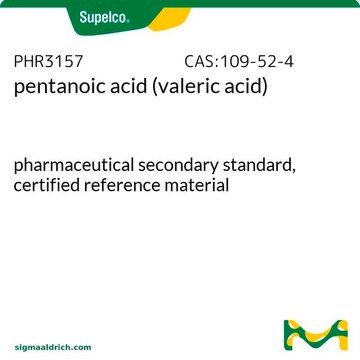75054
Valeric acid
analytical standard
Synonyme(s) :
n-Valeric acid, Pentanoic acid
About This Item
Produits recommandés
Qualité
analytical standard
Niveau de qualité
Densité de vapeur
3.5 (vs air)
Pression de vapeur
0.15 mmHg ( 20 °C)
Pureté
≥99.8% (GC)
Température d'inflammation spontanée
707 °F
Durée de conservation
limited shelf life, expiry date on the label
Limite d'explosivité
7.6 %
Technique(s)
HPLC: suitable
gas chromatography (GC): suitable
Indice de réfraction
n20/D 1.408 (lit.)
n20/D 1.408
Point d'ébullition
110-111 °C/10 mmHg (lit.)
185 °C (lit.)
Pf
−20-−18 °C (lit.)
Densité
0.939 g/mL at 25 °C (lit.)
Application(s)
cleaning products
cosmetics
flavors and fragrances
food and beverages
personal care
Format
neat
Chaîne SMILES
CCCCC(O)=O
InChI
1S/C5H10O2/c1-2-3-4-5(6)7/h2-4H2,1H3,(H,6,7)
Clé InChI
NQPDZGIKBAWPEJ-UHFFFAOYSA-N
Vous recherchez des produits similaires ? Visite Guide de comparaison des produits
Catégories apparentées
Description générale
Application
Mention d'avertissement
Danger
Mentions de danger
Classification des risques
Aquatic Chronic 3 - Eye Dam. 1 - Skin Corr. 1B
Code de la classe de stockage
8A - Combustible corrosive hazardous materials
Classe de danger pour l'eau (WGK)
WGK 1
Point d'éclair (°F)
192.2 °F - closed cup
Point d'éclair (°C)
89 °C - closed cup
Équipement de protection individuelle
Faceshields, Gloves, Goggles, type ABEK (EN14387) respirator filter
Choose from one of the most recent versions:
Déjà en possession de ce produit ?
Retrouvez la documentation relative aux produits que vous avez récemment achetés dans la Bibliothèque de documents.
Les clients ont également consulté
Notre équipe de scientifiques dispose d'une expérience dans tous les secteurs de la recherche, notamment en sciences de la vie, science des matériaux, synthèse chimique, chromatographie, analyse et dans de nombreux autres domaines..
Contacter notre Service technique










